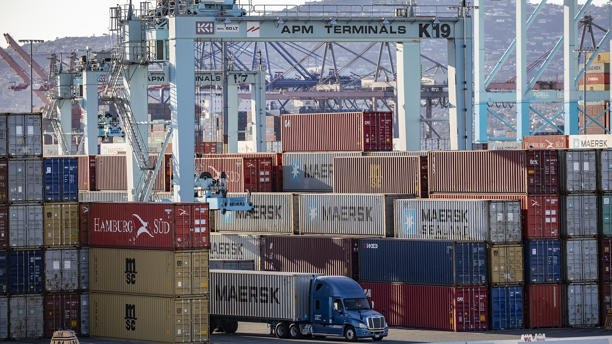Story by Deborah Belgum
Warehouses in Southern California are so stocked with goods that there is no room to cram in any more merchandise. Consumers are buying less, and an early Chinese New Year this year shut down many factories for longer periods of time than normal.
All those factors tumbled together to create one of the slowest Februarys on record for cargo container traffic at the Port of Los Angeles and the Port of Long Beach.
“The decline was steep,” said Gene Seroka, the executive director of the Port of Los Angeles, who announced the port’s monthly results in a Friday online press conference.
He said loaded imports in February plummeted 41 percent over the same month last year, coming in at 249,407 20-foot containers. Loaded exports were off by 14 percent at 82,404 cargo containers, and landed empty cargo containers nosedived 54 percent.
“This is a global phenomenon. We may not be at the height of the pandemic, but there are more container vessels sitting idle around the world today than at any time since the pandemic began,” Seroka said. “Spot container rates have declined to nearly three-year lows. Why? The demand is just not there. And that leads to my second point. Warehouses remain largely full. Retailers must clear inventory levels before the next wave of imports arrive.”
It was a similar story at the neighboring Port of Long Beach. Cargo container imports in February shrank 34.7 percent to 254,970 20-foot containers over the same period last year, and exports decreased 5.9 percent to 110,919 20-foot containers.
Mario Cordero, the Long Beach port’s executive director, pointed out that a shift in trade routes to the East Coast and inflationary-induced price increases led to falling consumer demand and less cargo arriving by ship. Meanwhile, retailers continue to clear their warehouses.
Seroka said the Port of Los Angeles will continue to see slow traffic at the beginning of this year with first-quarter results expected to be off by one-third over last year and 21 percent below the five-year average.
While port executives are optimistic that cargo container volumes will return to normal by peak shipping season later this year, there is still one sticking point to resolve. The contract between the ports’ longshore workers and their employers, the terminal operators, expired last July.
Negotiations between the International Longshore & Warehouse Union and the Pacific Maritime Association have been on and off and on again for nearly a year in San Francisco to determine the five-year contract for the 22,000 docker workers at 29 West Coast ports.
Labor uncertainty has pushed some shippers to reroute their cargo to East Coast ports including New York/New Jersey; Savannah, Georgia; and Mobile, Alabama. “I don’t know if we are any closer [on a contract], but the two sides continue to meet in good faith,” Seroka said.
One concern was that Marty Walsh, the U.S. secretary of labor who had been aggressively pushing both sides to reach an agreement, announced in February that he was leaving the Biden administration to become the executive director of the NHL’s players union. Some were worried his departure would affect a contract resolution, but President Biden said he plans to nominate Julie Su, the deputy labor secretary and a former California labor secretary, to step in.
She is quite familiar with longshore worker negotiations involving California ports. “She knows both the ILWU and the PMA very well,” Seroka said. “And she understands the port business here on the West Coast. We remain in constant contact with her.”

